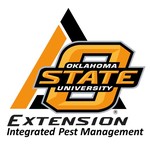
Sugarcane aphids typically infest grain sorghum at pre-boot through grainfill and even into harvest. They can be managed with foliar-applied insecticides, but must be applied in a timely manner when numbers within the recommended treatment threshold. Follow the suggested sampling method to determine if a field needs to be treated with an insecticide.
Inspect fields weekly. First indication of sugarcane aphid infestations is the presence of honeydew on the upper surface of leaves which appears to be "shiney". Look at the underside fo the leaf just above the "shiney" leaf for aphids. Once sugarcane aphid is detected in a field, inspect the field twice per week.
- Walk at least 25 feet into the field and check 3 consecutive plants, examining one upper and one lower leaf on each plant
- Estimate the average number of aphids per leaf (= total number of aphids/2 leaves) that you found on each plant
- Move 5 feet foward and inspect 3 more plants. This is considered to be one stop
- Walk 50 feet into the field (in an inverted "U" pattern and sample six more plants just like you did for the first stop
- Continue untill you have completed 9 stops (54 plants total)
- Estimate the percentage of plants that averaged 50 or more aphids per leaf (# plants with 50 or more aphids/54 * 100
Treatment thresholds:
- before panicle emergence: 20% plants infested with 50 or more aphids per leaf
- after panicle emergence: 30% plants infested with 50 or more aphids per leaf
There are many sorghum hybrids that are resistant to sugarcane aphid. Check with your seed dealer to select resistant hybrids best adapted to your location and planting time. While these resistant hybrids are not "immune" to sugarcane aphid, they typically reduce sugarcane aphid reproduction and survival so the aphid numbers increase much more slowely. Fields planted with these hybrids must still be scouted and treated if needed, using the same treatment threshold.
The user is responsible for determining that the intended use is consistent with the label of the product being used. Use pesticides safely. Read and follow label directions. The information given herein is for educational purposes only. Reference to commercial products or trade names is made with the understanding that no discrimination is intended and no endorsement by the Oklahoma Cooperative Extension Service is implied.
Sivanto Prime: 4 to 7 oz/acre
Transform WG: 0.75 to 1.5 oz/acre
(read all instructions on the label for application spray volume, minimum interval between applications, pre-harvest interval, pollinator protection restrictions)
